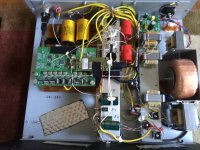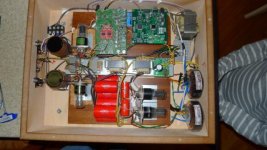Is anybody seriously paying $4500 for this ?? It really looks like one of our own
I thought at the first look that the ad had an error in zeros .
http://www.audioasylumtrader.com/ca...ndition-6-Months-Old-Jensen-Copper-Caps/97422
I thought at the first look that the ad had an error in zeros .
http://www.audioasylumtrader.com/ca...ndition-6-Months-Old-Jensen-Copper-Caps/97422
Attachments
Last edited:
Personally for something with digital present I would prefer a neater layout, less long interconnects between sections (example the white and brown wires that go to what look like valve bases), and some thought to EMC. Just my personal view, but well engineered products Commercial or DIY look tidy and well thought out. This looks like a development project, not the finished thing.
What are the wood blocks for?
What are the wood blocks for?
all of the reviewers can't be wrong
Given who reviews stuff like this (and that's a very limited set), sure they can be.
If someone is offering a unit that looks like it was vomited from a junk-box, then had the parts rearranged by a palsied lemur, and they're charging $4500 for it, then yes, one can make some judgments.
I've seen schematics for some of the Lampizator circuits. They are... original.
I've seen schematics for some of the Lampizator circuits. They are... original.
If someone is offering a unit that looks like it was vomited from a junk-box, then had the parts rearranged by a palsied lemur, and they're charging $4500 for it, then yes, one can make some judgments.
I've seen schematics for some of the Lampizator circuits. They are... original.
SY, do tell me about the last time you listened to music with your eyes
People "listen" to equipment all the time with their eyes- and preconceptions. This is a matter of a commercial piece of gear, and a damned expensive one, that has hilariously incompetent construction. If I paid 20x what is necessary to get good, accurate performance from a DAC, I'd expect high reliability, beautiful construction, and impeccable design. As much as I discount the sonic claims of some of the audiophile jewelry merchants, at least they are offering the user Mercedes-quality construction for their Mercedes-level prices.
If you're happy laying out a couple of mortgage payments for a unit that is assembled with all the quality and care of state fair macaroni art from "special" 4th grade students, that's certainly your privilege.
If you're happy laying out a couple of mortgage payments for a unit that is assembled with all the quality and care of state fair macaroni art from "special" 4th grade students, that's certainly your privilege.
"If I paid 20x what is necessary to get good, accurate performance from a DAC, I'd expect high reliability, beautiful construction, and impeccable design..."
Of course, while all of those can play valid roles in a purchase decision, they have nothing to do with the point I was making. My point is simply, that one cannot tell how a component will sound from the way it looks. Is that really so radical a statement of truth?
Of course, while all of those can play valid roles in a purchase decision, they have nothing to do with the point I was making. My point is simply, that one cannot tell how a component will sound from the way it looks. Is that really so radical a statement of truth?
But you often can tell how a circuit will sound from the way the circuit diagram looks. As SY said, Lampizator's circuits tend to be "original". His explanations of how his circuits work and why he has done them that way show similar "originality".Ken Newton said:My point is simply, that one cannot tell how a component will sound from the way it looks.
NB In this context, the description "original" should not be taken as a compliment!
I don't know a thing about the gadget, but it took me quite a while (decades) to build things that both looked good and worked well. I remember a particular amplifier where I put way too much time into laying it out "nicely" and ended up with insurmountable oscillation problems. I ripped it completely apart and rebuilt it with attention to wire lengths and coupling and it's worked well for the last 30+ years. All that said, yes, there are some construction details in those photos that you wouldn't expect to find in a commercial product. A shaker table would tell the tale in short order.
This has digital circuitry in it...
As I said earlier its layout looks terrible and badly put together.
Well constructed equipment can be made and be made to work, and generally shows some concern and forward planning (ie getting cable lengths correct).
Myself, I would be embarrassed to even show something that looked like that unless it was a prototype.
I have not been able to find out much, but does this thing have valve outputs?
Yes.
Any pictures of the PCB, the one on Lampizator site seems to be missing...
http://lampizator.eu/newdac/L5/L5_dacstory.html
As I said earlier its layout looks terrible and badly put together.
Well constructed equipment can be made and be made to work, and generally shows some concern and forward planning (ie getting cable lengths correct).
Myself, I would be embarrassed to even show something that looked like that unless it was a prototype.
I have not been able to find out much, but does this thing have valve outputs?
Yes.
Any pictures of the PCB, the one on Lampizator site seems to be missing...
http://lampizator.eu/newdac/L5/L5_dacstory.html
Last edited:
What are the wood blocks for?
As you noticed, there is a piece of wood inside every DAC chassis. It is not a decor and it is not some mysterious voo doo element. We simply discovered strong dependency between the sound quality and the proximity of grounded steel planes to the DAC chip. That means that if the DAC chip "sees" a steel grounded object in the proximity of say 10 cm - it will somehow choke the sound. Without solving that mystery scientifically - we decided to remove the steel floor from underneath the entire PCB and replace it with a nice wooden flooring. For the same reason we eliminated the steel top cover and replaced it with aluminum one. The music flows free and unrestricted. Magnetically speaking, the DAC pcb is floating in the air.
You'll enjoy the grounding explanation as well:
As far as grounding is concerned, the grounding scheme of the DAC is a pure star. Every negative wire is connected to the same screw by means of a thick copper wire. Our experiments show, that for products as complex as the DAC, where there are many very different electrical circuits such as digital chip supplies, tube musical signal ground, high voltage DC ground, filaments low voltage / high current AC supplies with virtual ground. etc. etc. - there is only one solution that brings absolute peace of mind and electronic silence and that's a star.
It is the most difficult and costly and labor intense system but we decided that for L5 there will be no departure from star, end of story.
We join in the star as many as 20 separate lines. In this fashion the electrical interaction between individual circuits within the DAC is ZERO.
See? Original.
Yes, it's quite scary and expensive all at the same time. This is the "BigSix".
Have a good laugh here LampizatOr Rave
Have a good laugh here LampizatOr Rave
Attachments
Last edited:
The phrase "you couldn't make it up" comes to mind, but someone has. Visited the site, some original ideas
I suspect that in the photos the output of the DACs are fed to the valves for filtering, with what looks like two single wires, one per channel, with no adjacent ground lead...
I would love a close up view of the PCB, one wonders whether that uses star grounding, just what digital or low level analogue wants.
So the wood protects the delicate DAC from the grounded steel, now maybe I am missing something here BUT, if the steel effects the DAC and is protected by the wood (any particular species!) wouldn't using a non steel base say aluminium be a better way of solving the problem.

Of course that would remove the need for endless happy hours comparing different bits of wood and their effect on the sound.
Ha vibration proof as well as excellent EMC shielding, I believe the secret though is in the special tongue and groove pattern...
I notice on the other site linked that mention the measurement word and they are shouting for moderators to protect them from evils trolls who ruin their dreams with reality...
I notice on the other site linked that mention the measurement word and they are shouting for moderators to protect them from evils trolls who ruin their dreams with reality...
- Status
- This old topic is closed. If you want to reopen this topic, contact a moderator using the "Report Post" button.
- Home
- Source & Line
- Digital Source
- lampizator



